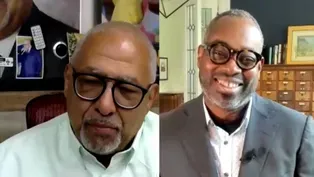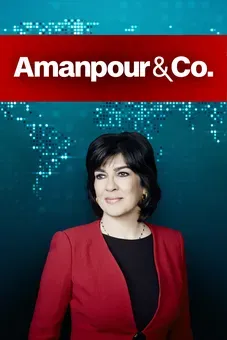
‘Tiff Massey: 7 Mile + Livernois’ exhibit at the DIA
Clip: Season 52 Episode 24 | 9m 59sVideo has Closed Captions
A new exhibit at the Detroit Institute of Arts pays homage to Black Detroiters’ culture.
A new exhibit at the Detroit Institute of Arts pays homage to Black Detroiters’ style and culture. “7 Mile + Livernois,” was created by Detroit artist Tiff Massey, a metalsmith and sculptor. It's the largest exhibition by a Detroit artist at the museum. Host Stephen Henderson talks with Massey about why she named the exhibit after the Detroit neighborhood where she grew up.
Problems with Closed Captions? Closed Captioning Feedback
Problems with Closed Captions? Closed Captioning Feedback
American Black Journal is a local public television program presented by Detroit PBS

‘Tiff Massey: 7 Mile + Livernois’ exhibit at the DIA
Clip: Season 52 Episode 24 | 9m 59sVideo has Closed Captions
A new exhibit at the Detroit Institute of Arts pays homage to Black Detroiters’ style and culture. “7 Mile + Livernois,” was created by Detroit artist Tiff Massey, a metalsmith and sculptor. It's the largest exhibition by a Detroit artist at the museum. Host Stephen Henderson talks with Massey about why she named the exhibit after the Detroit neighborhood where she grew up.
Problems with Closed Captions? Closed Captioning Feedback
How to Watch American Black Journal
American Black Journal is available to stream on pbs.org and the free PBS App, available on iPhone, Apple TV, Android TV, Android smartphones, Amazon Fire TV, Amazon Fire Tablet, Roku, Samsung Smart TV, and Vizio.
Providing Support for PBS.org
Learn Moreabout PBS online sponsorshipA new exhibit at the Detroit Institute of Arts combines black identity with Detroit history and culture in a first of it's kind art installation, it's called Tiff Massey: Seven Mile and Livernois, and it features 11 works from the Detroit artist, who creates jewelry, sculpture, performance videos, music, and immersive art environments.
Massey is the first African American woman to earn a Master of Fine Arts in metalsmithing at Cranbrook Academy of Art.
I spoke with her about the exhibit, and about her artistic journey.
Tiff Massey, it is always great to see you, welcome to "American Black Journal".
- Thank you, I'm happy to be here.
- Yeah, so, Seven Mile and Livernois, I know why you've titled your exhibition this, but tell our viewers why that's the title of your show.
- So the name of the exhibition is Seven Mile Livernois, because that's my home, that's where I grew up, that is probably like some of the first inspirations that I've seen, blackness, opulence, you know, people going outside with their best attire because, of course, like, we're Detroiters, we like to stunt, we, you know, all of us are a celebrity in our own rights.
(Stephen laughing) And so we all, you know, tryna put on a show, essentially is what it is.
So it's, you know, fashion, it's the avenue of fashion, and you know, really it's a call to blackness.
Usually, when you hear native Detroiters talk about like where they are from, a lot of times the intersection of Seven Mile Livernois comes up, and so I think it just made all the sense in the world to basically represent, you know, the area that basically made me, and to actually highlight other, you know, black Detroiters, essentially.
- So when I think of Seven Mile and Livernois, I also think about African Americans and African American history, but I think of an intersection of different parts of our history in the city.
I mean, on those four corners, you do have this really broad spectrum, you know, of the black experience in Detroit.
How much of that are you trying to communicate in the exhibit as well?
- Well, really it's like representing.
So, I'm the youngest artist to ever exhibit at the DIA, and I might be the second black woman to exhibit, and so like, I'm gonna represent to the fullest and so like, if I say Seven Mile and Livernois, it's just really, you know, for the people who know what that is.
- Mhm.
- You know what I'm saying?
And then, it's for everybody else who does not know what that is, to come to the DIA and find out, you know, how I've been inspired from growing up in this area and to create the objects that they see.
- Yeah, yeah.
Let's talk about what's in the exhibit, and how you tell that story of this intersection, this corner.
- Okay well, I'm saying it's really not about the corner.
The corner is just the call to blackness.
You know?
- Right, right.
- [Tiff] And so, like, I'm a jeweler, I'm an interdisciplinary artist, and that's how my art practice formed.
And basically I started to take the body outside of the wearable experience and started to adorn walls, landscapes, and things like that.
And so one of the largest pieces in the exhibition is 15,000 pound necklace.
- Mhm, yeah, yeah.
Let's talk about the firsts here, as you point out, your age, the fact that you're a woman, the fact that you're a black woman, these are all important details about the DIA deciding even to feature this and to feature it for as long as they are, it's a full year.
It's a big, big deal for the museum and for our city.
- It is, to have, you know, the largest platform in the nation, the DIA is, you know, just named the top museum in the nation, and so yes, it's a serious platform to give to Detroiters, but we, Detroiters, deserve all of the platforms.
There's a lot of sauce that is here, and I think it is very much so present, the level of skill and craftsmanship that I possess in my art practice of why I have that platform.
- Yeah.
So, how do you put together an exhibit of this scale?
Like, when you think about what goes in, what doesn't, and why, where do you even start with something this big and expansive?
- Well, you get a little help from your friends, because there's no way that you can actually produce an exhibition on this scale on your own.
- Yeah.
- You know.
Usually with a lot of art practices, once you get to certain scales, and there's certain galleries or exhibition halls, you have a team, and so that is definitely what I have.
I think it was a team of five, initially, and then there were three or four other studios that were contracted to help facilitate the exhibition.
There was a rigging group that was hired from Chicago that basically deals with large scale installation and de-installation of sculptures, and so they were called in to assist too.
This is not a game, so, this is serious business, and you gotta have all the professionals basically on deck to facilitate it.
- Yeah, yeah.
So sculpture happens to be my favorite art medium, it's the one that speaks to me more than anything else, and so I'm always curious about what draws artists to that form.
Talk about how that became the medium, or at least one of the mediums, that you work in, this idea of 3D form and the messages that you can send with it.
- Well, I got into sculpture primarily being the medium that I work because I basically increased the scale of the jewelry.
I'm a classically trained metalsmith, I made jewelry ever since I was 16.
I picked up the torch for the first time attending Mercy High School in Farmington Hills.
- Mhm.
- And basically I picked up the torch again when I was pursuing a Bachelor's of Science to break up the monotony of learning all of these formulas, I wanted to be a veterinarian.
So, once realizing how rare I am for the amount of talent in metalsmithing and not seeing reflections of myself and, you know, participating heavy in contemporary art jewelry, and realizing that they haven't seen reflections of myself and realizing that the industry has a level of racism, that it was nothing that I actually wanted to participate in, so basically, you know, you can't put me in the contemporary art jewelry category if the jewelry isn't wearable.
So I took the body out, made the jewelry larger, wasn't necessarily interested in having the individualized experience of making one of a kinds, or smaller objects, and so usually I will make some objects for myself, and then instantly they need to be larger.
So- - Mhm.
- You know, you see examples of that in the exhibition, I have a room that is dedicated to my jewelry box, and is basically referring to the times that I would actually go and get custom jewelry made with my father, because that's what we do on Seven Mile, we get custom stuff.
(Stephen laughing) We don't want anybody to look like us at all, and that's my influences, that's what it is, it's pure blackness, the diaspora, growing up in the '80s, hip hop, jewelry, you know, just seeing the scales there.
And so basically it's like, how many people can I adorn at once?
I mean, if I have a necklace that is 15,000 pounds and each links are basically 10 feet tall, then that means I can adorn multiple people at once.
- Yeah, yeah.
What do you want people to take away from this exhibition, people who go see it?
- I want them to tell me.
You know, my Instagram is "Tiff_Massey", y'all let me know what y'all feel.
I mean, I have some quotes and things that are on the walls, but, you know, I'm not tryna tell anybody how to feel.
And so we're scheduling a artist talk, probably during the month of design, so stay tuned to that, that is in September.
So then I can tell everybody what I felt, but, you know, it's really not about me once I birth these objects, it's really about what does everybody else feel.
- Yeah, yeah.
Okay, well, Tiff Massey, it is, as I said, always great to see you, and it's especially great to see you in light of this new exhibition, which again, is a major, major achievement, not just for you, but also for the museum, turning that corner and featuring an artist like yourself.
Thanks so much for being with us here, on "American Black Journal".
- Yes, thank you.
You have a good one, take care.
DABO launches free Community Empowerment Speaker Series
Video has Closed Captions
Detroit Association of Black Organizations’ launches Community Empowerment Speaker Series. (11m 56s)
Providing Support for PBS.org
Learn Moreabout PBS online sponsorshipAmerican Black Journal is a local public television program presented by Detroit PBS












